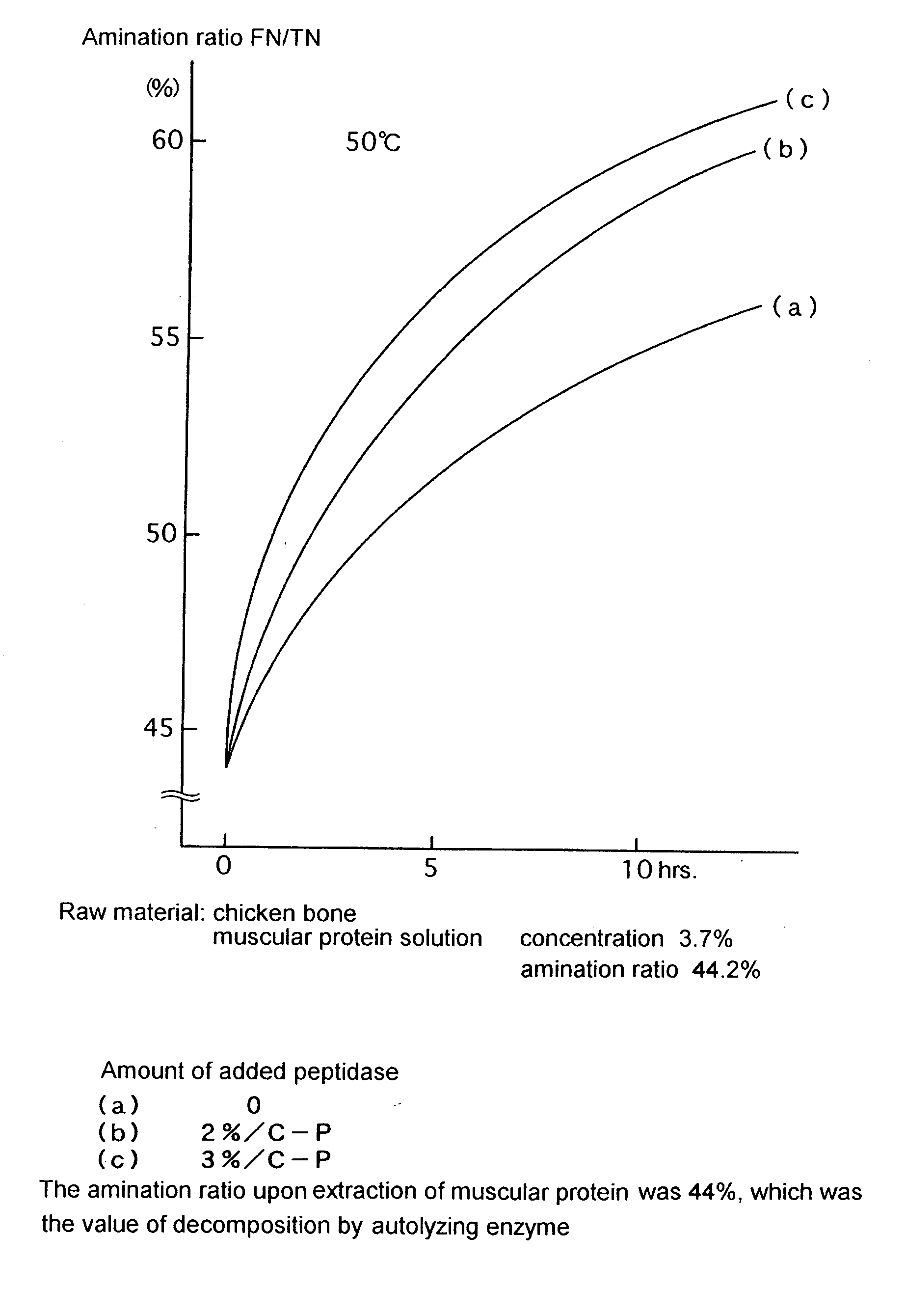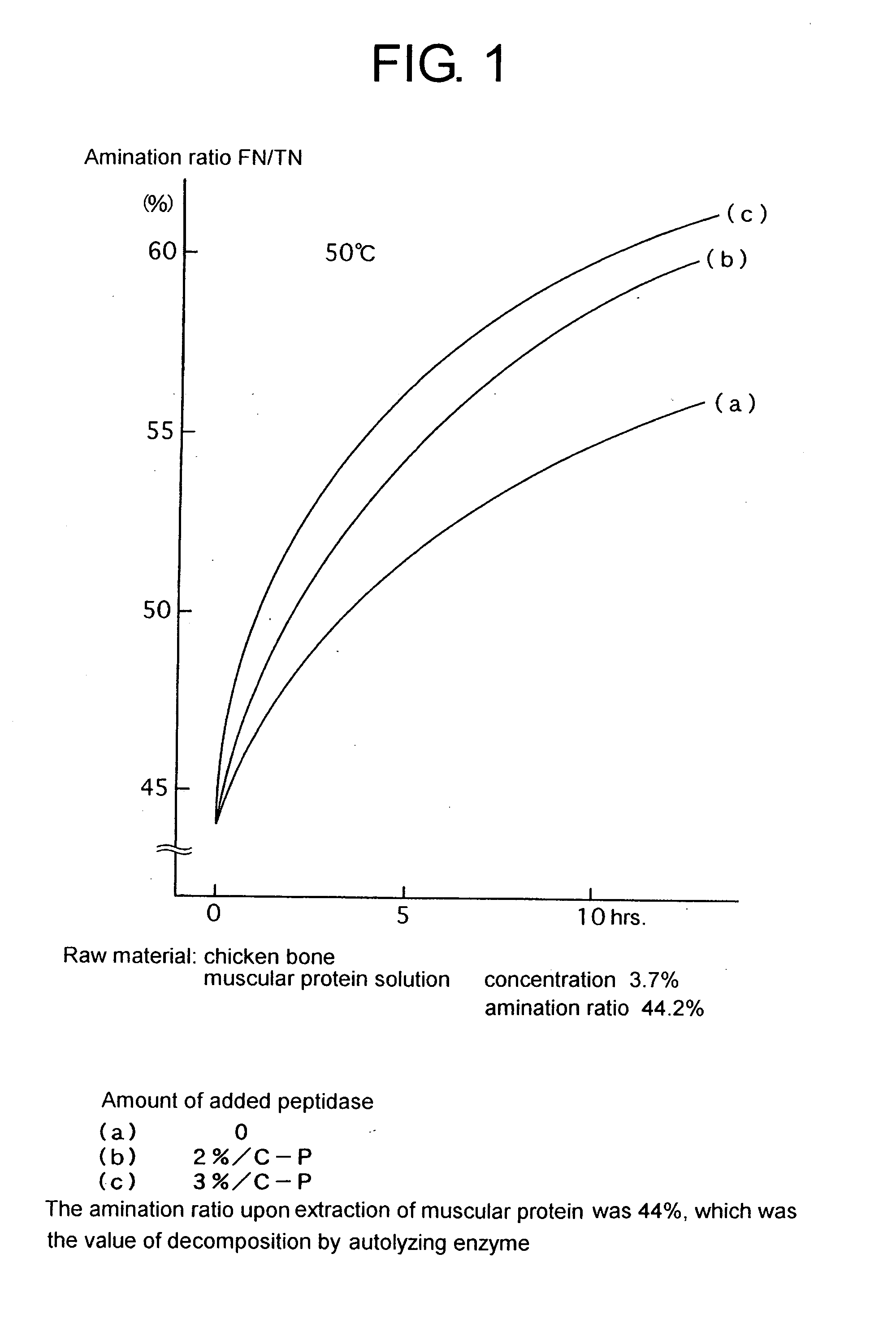Process for producing protein hydrolysate and protein hydrolysate
a technology of protein hydrolysate and hydrolysate, which is applied in the field of process for producing protein hydrolysate and protein hydrolysate, can solve the problems of poor cost performance, difficult high decomposition, and inability to find appropriate seasonings, and achieves efficient decomposition and less structural protein. , the effect of improving efficiency
- Summary
- Abstract
- Description
- Claims
- Application Information
AI Technical Summary
Benefits of technology
Problems solved by technology
Method used
Image
Examples
example 1
(Seasoning Prepared by Enzymatic Decomposition Produced from Chicken Meat)
[0113] 25 kg of water was added to 10 kg of minced chicken meat and heated while stirring up to 45° C. 10 g of protein decomposing enzyme (Protease N (Amano Pharmaceutical Co., Ltd.)) was added thereto and stirred for one hour. Then, the resultant mixture was filtrated with a wire mesh of 30 mesh to separate solid matter.
[0114] The solution after filtration was centrifuged to remove oil and fat contents. With additional 50 g of enzyme (Protease P (Amano Pharmaceutical Co., Ltd.)) to 30.7 kg of the resultant solution, the solution was decomposed at 55° C. for 15 hours.
[0115] After decomposition, the enzyme was deactivated by heating at 90° C. for 30 minutes, followed by removing insoluble matter to obtain a transparent solution.
[0116] The obtained solution was condensed to have 35% solid contents with a vacuum condenser, and deposited precipitation was removed, followed by further condensation. As a result...
example 2
(Seasoning Prepared by Enzymatic Decomposition Produced from Chicken Bone)
[0121] 20 kg of water was added to 10 kg of minced chicken bone and heated with stirring to 45° C.
[0122] 32 g of enzyme (Alkarase (Novo Nordisk Pharma Ltd.)) was added and stirred for one hour. Then, the resultant mixture was filtrated with a wire mesh of 30 mesh to separate solid matter.
[0123] The solution after filtration was centrifuged to remove oil and fat contents and decomposed with stirring at 50° C. for 12 hours.
[0124] After heating at 90° C. for 30 minutes, insoluble matter was removed, and the solution was condensed to have 35% solid contents. Deposited precipitation was filtrated, followed by further condensation, to obtain 1.3 kg of seasoning prepared by enzymatic decomposition having 70% solid contents.
[0125] 10.5 kg of water was added to 5.2 kg of solid matter separated with a wire mesh and heated at 90° C. for 30 minutes.
[0126] After removing insoluble matter and oil and fat contents, th...
example 3
(Seasoning Prepared by Enzymatic Decomposition Produced from Culled Chicken)
[0128] 20 kg of water was added to 10 kg of minced culled chicken (carcasses without organs) and heated with stirring up to 45° C. 10 g of enzyme (Orientase 90N (HBI Enzymes Inc.)) was added thereto and stirred for 2 hours. The resultant mixture was filtrated with a wire mesh of 30 mesh.
[0129] The solution after filtration was centrifuged to remove oil and fat contents. With additional 25 g of enzyme (Flavorzyme (Novo Nordisk Pharma Ltd.)) to 21.5 kg of the resultant solution, the solution was decomposed at 50° C. for 15 hours.
[0130] After decomposition, the solution was heated at 90° C. for 30 minutes, followed by removing insoluble matter to obtain 21.0 kg of transparent solution.
[0131] The obtained solution was condensed to have 35% solid content, and deposited precipitation was removed, followed by further condensation. As a result, 1.38 kg of seasoning prepared by enzymatic decomposition having 70%...
PUM
| Property | Measurement | Unit |
|---|---|---|
| temperature | aaaaa | aaaaa |
| digestibility | aaaaa | aaaaa |
| size | aaaaa | aaaaa |
Abstract
Description
Claims
Application Information
 Login to View More
Login to View More - R&D
- Intellectual Property
- Life Sciences
- Materials
- Tech Scout
- Unparalleled Data Quality
- Higher Quality Content
- 60% Fewer Hallucinations
Browse by: Latest US Patents, China's latest patents, Technical Efficacy Thesaurus, Application Domain, Technology Topic, Popular Technical Reports.
© 2025 PatSnap. All rights reserved.Legal|Privacy policy|Modern Slavery Act Transparency Statement|Sitemap|About US| Contact US: help@patsnap.com



